View in other NatureServe Network Field Guides
NatureServe
Montana
Utah
Wyoming
Idaho
Wisconsin
British Columbia
South Carolina
Yukon
California
New York
Great Basin Indian-potato - Orogenia linearifolia
Other Names:
Orogenia fusiformis [incorrectly applied to Montana], Lomatium linearifolium
Native Species
Global Rank:
G4
State Rank:
S4
(see State Rank Reason below)
C-value:
Agency Status
USFWS:
USFS:
BLM:
External Links
State Rank Reason (see State Rank above)
Orogenia linearifolia is known from several southwest Montana counties where it occurs mainly on National Forest lands. Several of the populations are large in size and extensive in distribution. A few of the populations on the Bitterroot National Forest contain minor infestations of spotted knapweed. However, other threats to populations in Montana appear to be minimal. Livestock grazing in occupied habitat does not appear thus far to have detrimental impacts. This species blooms early in the spring before most surveys take place, thus the "discovery" of additional populations is likely.
- Details on Status Ranking and Review
Population Size
Score1 - Moderate: Generally 10,000-100,000 individuals.
Range Extent
Score2 - Regional or State Endemic or Small Montana Range: Generally restricted to an area <100,000 sq. miles (equivalent to 2/3 the size of Montana or less) or Montana contributes 50% or more of the species’ range or populations OR limited to 2-3 Sub-basins in Montana.
Area of Occupancy
Score0-1 - Moderate to High. Occurs in >10 Subwatersheds (6th Code HUC’s), though the species' distribution is not sufficiently documented to place it within one class.
CommentDocumented from approximately 20 sub-watersheds and it likely occurs within additional ones.
Environmental Specificity
Score0-1 - Low to Moderate.
Trends
ScoreNA - Rank factor not assessed.
Threats
Score0-1 - Low to Medium.
CommentThough the potential for negative impacts from grazing, weeds, roadside activties likely exist at some sites, none appear to be severe and/or widespread and are probably limited to less than 10% of the populations.
Intrinsic Vulnerability
Score0-1 - Low to Moderate Vulnerability.
Raw Conservation Status Score
Score
3 to 7 total points scored out of a possible 16 (Rarity factors and threats only).
General Description
Orogenia is a glabrous perennial herb that usually has a single leafless stem that is 1-4 cm high, arising from a globose (to fusiform in Montana material) root located 2-7 cm beneath the soil surface. The 2-3 basal leaves have petioles and blades that are twice divided into strap-shaped leaflets that are 10-45 mm long and 1-4 mm wide. Tiny, white flowers are borne in a few hemispherical clusters arranged at the ends of 1-2 cm long stalks in an open inflorescence at the top of the stem. Flowers have 5 separate petals surmounting an ovary that matures into a glabrous, elliptical fruit that is 3-4 mm long with obscure ridges on the outer face.
Phenology
Flowering and fruiting from the end of April thru May. Plants are difficult to detect by early summer.
Diagnostic Characteristics
The shape of the root in Montana specimens varies from the typical globose form to the more fusiform (thick, tubular) root structure of Orogenia fusiformis which has led to confusion as to the identity of Montana material. Cronquist (Intermountain Flora Vol 3A, 1997) noted that Utah material also tends to have a more fusiform root structure than is typically found in Orogenia linearifolia. The small size and early spring maturity make this plant difficult to detect during many surveys.
Species Range
Montana Range
Range Descriptions
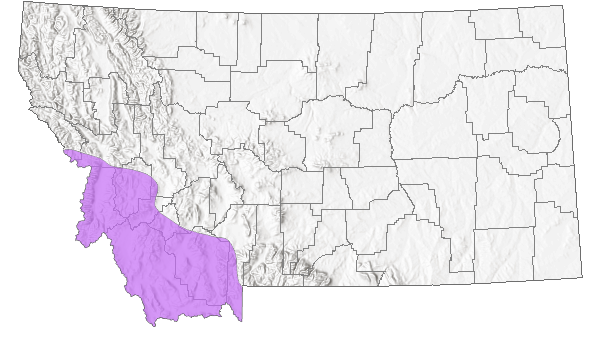
 Native
Native
Range Comments
WA to MT south to ID, UT and WY (Lesica et al. 2012. Manual of Montana Vascular Plants. BRIT Press. Fort Worth, TX).
Observations in Montana Natural Heritage Program Database
Number of Observations: 129
(Click on the following maps and charts to see full sized version)
Map Help and Descriptions
Relative Density
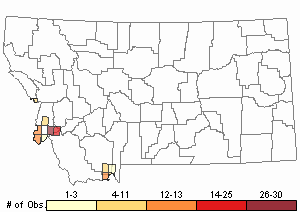
Recency
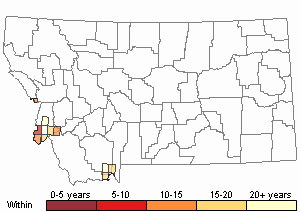
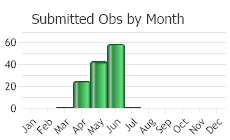
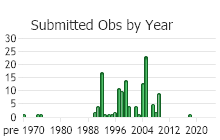
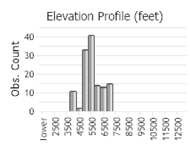 (Observations spanning multiple months or years are excluded from time charts)
(Observations spanning multiple months or years are excluded from time charts)
Habitat
Open slopes, ridges, and meadows, from the lower foothills to the mid-montane zone. Often associated with open forests or sagebrush steppe.
Stewardship Responsibility
References
- Literature Cited AboveLegend:
 View Online Publication
View Online Publication Lesica, P., M.T. Lavin, and P.F. Stickney. 2012. Manual of Montana Vascular Plants. Fort Worth, TX: BRIT Press. viii + 771 p.
Lesica, P., M.T. Lavin, and P.F. Stickney. 2012. Manual of Montana Vascular Plants. Fort Worth, TX: BRIT Press. viii + 771 p.
- Additional ReferencesLegend:
 View Online Publication
View Online Publication
Do you know of a citation we're missing? Lesica, P., M.T. Lavin, and P.F. Stickney. 2022. Manual of Montana Vascular Plants, Second Edition. Fort Worth, TX: BRIT Press. viii + 779 p.
Lesica, P., M.T. Lavin, and P.F. Stickney. 2022. Manual of Montana Vascular Plants, Second Edition. Fort Worth, TX: BRIT Press. viii + 779 p.
- Web Search Engines for Articles on "Great Basin Indian-potato"





